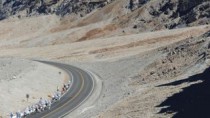WMO RELEASE
Death Valley, Calif. now holds the record for the hottest temperature ever recorded in the world with a maximum temperature of 134 degrees. This temperature was not recorded this past summer, but nearly 100 years ago on July 10, 1913. So, how can it be a new all-time record?
The World Meteorological Organization (WMO) released information on Thursday showing that the now previous all-time world record of 136 degrees on September 13, 1922 in El Azizia, Libya has been ruled invalid.
The investigation that discredited the previous record was conducted with the support of the Libyan National Meteorological Centre for the WMO Commission of Climatology World Archive of Weather and Climate Extremes.
Several factors were cited in ruling the previous record as invalid, including:
- Problematical instrumentation.
- An inexperienced weather observer.
- The observation site was over an asphalt-like material that was not representative of the native desert soil.
- Poor matching of the extreme temperature reading to other nearby locations that were cooler.
- Poor matching to subsequent temperatures recorded at the site.
Death Valley: The “Hot” Facts
The Badwater Ultramarathon is run in the brutal heat of Death Valley each year.

One hundred thirty-four degrees seems incomprehensible. This is 13 degrees hotter than the hottest temperatures measured in the Plains states during the “Dust Bowl” of the 1930s and 12 degrees hotter than the all-time record high at Phoenix Sky Harbor Airport.
In an average year Death Valley sees triple-digit heat from mid-May through early October. Highs in the 110s are common from mid-June through early September. Morning lows in the upper 80s or low 90s are frequent from mid-July through mid-August.
(FORECAST: Death Valley)
The summer of 1996 featured daytime highs over 120 degrees for forty days. Five years later, the valley sizzled in a stretch of 154 consecutive days of triple-digit heat, a roughly five-month stretch!
Those are just air temperatures. How hot can ground temperatures get? Try an incredible 201 degrees, measured at Furnace Creek on July 15, 1972. Yep...11 degrees from the boiling point of water! The maximum air temperature measured that day was 128 degrees.
Why is this Valley so Hot?
Elevation: Furnace Creek, home of the Death Valley Nat’l Park Visitor’s Center, is roughly 190 feet below sea-level. Since air warms as it moves down, that extra elevation plunge adds extra heat.
It’s a Desert: Only 2.26” of precipitation falls each year in the valley. The average evaporation rate: 150” a year. In some years (1953, 1929), no rain or snow fell. Most Pacific storm systems have the lion’s share of their moisture taken away by four mountain ranges to the west of Death Valley. Their wettest month, February, averages only 0.49” of precipitation. Amazingly, despite this desert environment, there have been destructive floods.
On August 15, 2004, torrential rain, by valley standards, sent walls of floodwater up to 8 to 10 feet deep through parts of Death Valley National Park in the late evening hours.
Miles of roads were washed out and closed for months. Cars were swept away and buried. Two people were killed near Zabriskie Point. The park was closed for nine days. Other destructive floods occurred in 1984 and 1976, among other years.




